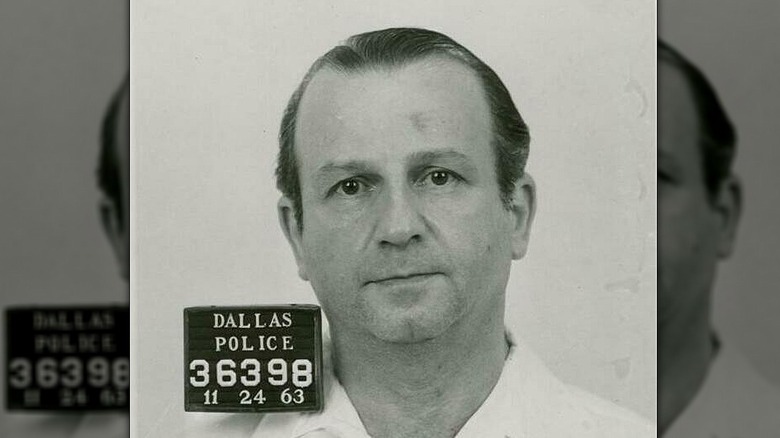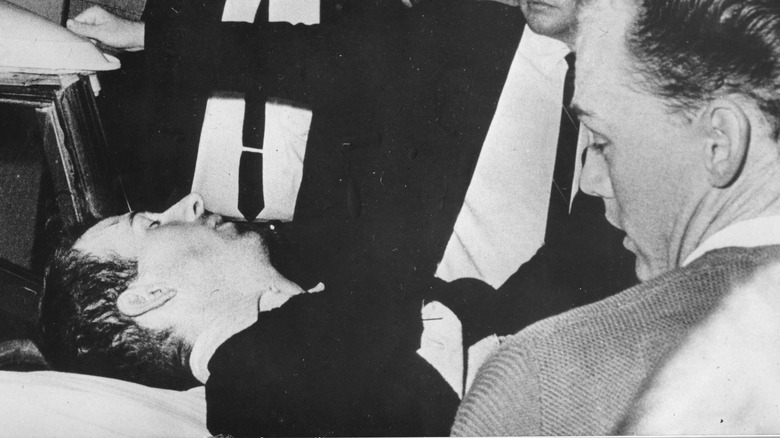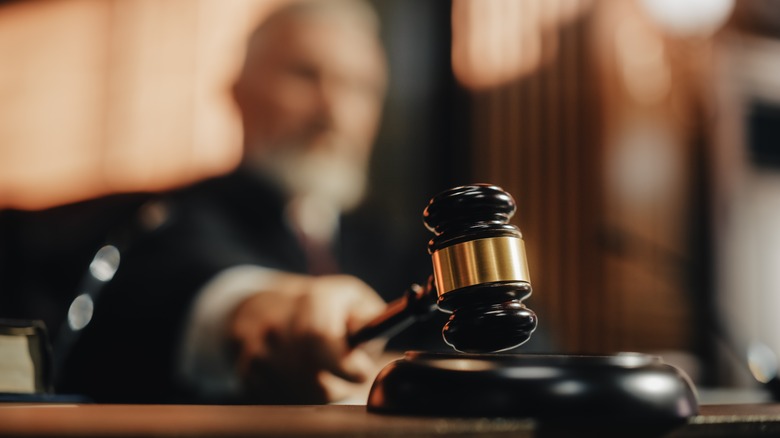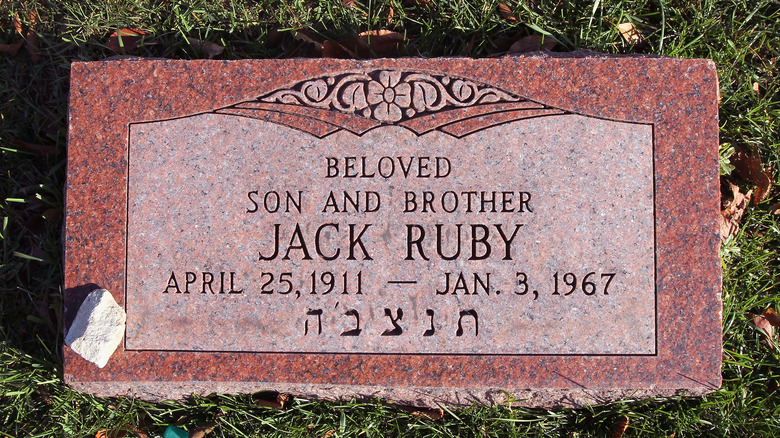What Happened To Jack Ruby After Killing JFK's Assassin, Lee Harvey Oswald?
On the morning of November 24, 1963, Lee Harvey Oswald slipped on a black sweater over his collared shirt just before Dallas police officers began moving him from the city lockup to the county jail. CBS News broadcast the event live. The police were holding Oswald on murder charges for assassinating President John F. Kennedy two days before, as well as for the shooting death of a Dallas police officer.
At 12:20 p.m. EST, as Oswald and the officers moved through the restricted hallway of the Dallas Municipal Court Building on their way to a waiting armored car they planned to use to transport the prisoner, a stocky man in a dark suit and gray fedora pushed past the reporters, shoved a .38 caliber pistol next to Oswald's body, and fired once. In the ensuing chaos, eight officers tackled the shooter, a Dallas nightclub owner named Jack Ruby, but it was too late. A few hours later Oswald died in Parkland Memorial hospital from a chest wound. And with his death arose a million JFK assassination conspiracy theories, helped along by the mysterious man who murdered Kennedy's killer.
Who was Jack Ruby?
Jack Ruby was born Jacob Rubenstein in Chicago in 1911. His parents, Polish Jews, immigrated to the U.S. in 1903. An unstable home life marked his childhood, and the county placed Ruby in foster care for a short stint. He left school early, became a ticket scalper, sold novelties from a pushcart, and often brawled with other young men in the mean streets of Chicago. He later worked as a union organizer and door-to-door salesman, among other work, and served stateside as a mechanic in the U.S. Army Air Forces during World War II.
By the late 1940s, he was living in Dallas, Texas, had changed his name to Jack Ruby, and operated a string of nightclubs, including strip joints. He racked up eight arrests for carrying a concealed weapon, simple assault, and disturbing the peace, among other violations (per National Archives). He counted Dallas police officers, gamblers, and various underworld figures as friends. In addition, sources suggested that Ruby's permission was required for the initiation of illegal activities in the region. two persons of questionable reliability have reported that Ruby's consent was necessary before gambling or narcotics operations could be launched in Dallas," the Warren Commission, established to look into Kennedy's assassination, wrote in their report.
Even so, the commission determined Ruby wasn't actively involved in mob-related business. "Based on its evaluation of the record ... the Commission believes that the evidence does not establish a significant link between Ruby and organized crime," the members wrote in the report.
Ruby was deemed legally insane by one expert
After Jack Ruby shot and killed Lee Harvey Oswald, the Dallas County state's attorney, Henry Wade, took the case to a grand jury that same week. "I am going to seek the death penalty because I think his case is an aggravated one," Wade told The Chicago Tribune. "This was a second assassination. The murder of a man under arrest and manacled and I feel that it is an extreme case."
Ruby sat in jail for more than three months, awaiting trial on murder charges. During this time, he repeatedly asked to speak to the Warren Commission so he could prove his innocence. "Jack Ruby expressed his desire to be examined with a polygraph, truth serum, or any other scientific device which would test his veracity," the commission stated in its report. Per the FBI, the interpretation of the results "depends on whether or not Ruby suffered from psychosis. A psychotic subject may not be able to distinguish true answers from false answers and may be convinced he is telling the truth, even though he is not." As reported by The New York Times, during his 1964 trial, psychiatrist Manfred Guttmacher testified that Ruby "experienced a psychotic episode" after encountering Oswald and was legally insane at the time of the murder.
Motives and death
Jack Ruby said he shot Oswald to spare Jackie Kennedy from having to come back to Dallas to attend the inevitable trial of her husband's assassin. To this day, many believe Ruby's motives involved some larger conspiracy involved in Kennedy's assassination, with some pointing to the Mafia and others to Fidel Castro, among a multitude of theories. The Warren Commission concluded that "on the basis of the evidence available to it, that President John F. Kennedy was probably assassinated as a result of a conspiracy. The Committee is unable to identify the other gunman or the extent of the conspiracy."
On March 14, 1964, a Dallas jury found Ruby guilty of murder with malice and sentenced him to death in the electric chair. The Texas Court of Criminal Appeals overturned the conviction two years later. But like Oswald, whose death prevented his murder trial, Ruby cheated the executioner. He died of a pulmonary embolism on January 3, 1967, before his retrial.
If you or someone you know needs help with mental health, please contact the Crisis Text Line by texting HOME to 741741, call the National Alliance on Mental Illness helpline at 1-800-950-NAMI (6264), or visit the National Institute of Mental Health website.



